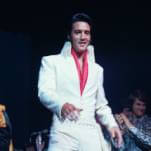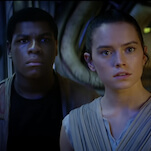The intentions of the show are to normalize homosexuality in the high school setting. But the problem is, Amy and Karma do not have a real relationship. While Amy begins to question the fakeness of her feelings toward Karma, Karma is full-blooded hetero teenage girl. By allowing these two to climb several rungs of high school hierarchy by coming out, Faking It tokenizes lesbianism. It’s clearly supposed to be revolutionary that straight teenagers are faking gay, rather than stigmatizing it. It’s certainly better than the ugly alternative, but by making lesbianism “cool”—rather than just a part of a person’s being—it becomes the defining characteristic of these two characters, even if their sexuality is a put on. This type of tokenism has been depicted onscreen before: In the gay film fest hit G.B.F., Willett plays the gay best friend vied for by three Regina George clones. But the lesson of that movie is that Willett’s character was more than just an accessory defined by his sexuality. Faking It may get to that point eventually, but there’s no sign of it just yet. Instead, the show further entrenches itself in labels, rather than characters.
Yet, Faking It is never jaw-droppingly offensive, if only because it’s so benign. Amy’s stepsister, Lauren, is meant to be the antithesis of Hester’s ideal. She’s blonde and mean, stomping around and screaming about how at any other school in Texas, she would be queen bee, instead of just another part of the hive. Played by Bunheads’ Bailey Buntain, Lauren is infused with the tongue-in-cheek cartoonishness that Faking It teeters on, but never fully commits to. Buntain brings a presence to Lauren, even if she’s just meant to play a one-noted, intolerant bitch. She pops where every other actor yawns. In the first episode, Lauren is pitted against Amy and Karma for homecoming queen(s) and attempts to out the “couple’s” deception in front of the whole school. “They’re mocking the gay rights’ movement!” she screeches from the stage. Girl’s got a point, even if it’s only in the pursuit of popularity. Maybe being removed from the show’s demo makes that pursuit feel more trivial, but what about the legions of gay kids who didn’t get a popularity bump when they came out? What about the kids who don’t live in the idyllic paradise that is the Hester High? How is it going to feel for them to see the acceptance they so sorely crave bestowed upon a couple of girls who don’t ever really have to face their struggle? Series developer Carter Covington has defended the idea, saying that it it tells the story of a bold new generation who hold tolerance above all else, but telling that story through the eyes of a straight girl does not feel like the vehicle to do it.
Questionable taste aside, there are major narrative issues at work in Faking It that go beyond sustaining the faux relationship between Amy and Karma. Tonally, it can never decide to satirize the type of über-tolerance on display at Hester High—as 21 Jump Street did—or hold it in high esteem. Buntain is the show’s secret weapon, but Stevens is the next best thing, though her character is so inherently problematic that it’s too much for her to handle as a young actress. Karma has the hots for sensitive artist Liam (Disney Channel vet Gregg Sulkin), who in the first episode is seen rebuffing the advances of his drunk fuck buddy, because he just wants to be honest about his sex-only intentions, mirroring the actions of no teenage boy ever. Liam and Karma are attracted to each other and end up hooking up, leading to a secret relationship, even though Liam believes that Karma proudly waves the rainbow flag. It’s hard to root for a character who fakes lesbianism for popularity. It’s even harder when that same character cheats on her fake girlfriend in order to hook up with a guy who is convinced he’s turned her hetero.
There’s a missed opportunity here—to explore the closeness of female friendship that can sometimes feel like a romantic relationship—but Faking It ignores that to focus on labels. A bland high school comedy, it’s as empty a gesture as two drunk, straight girls grasping for attention by making out in front of a group of hollering guys. Once the initial excitement fades, they’ll still have to deal with the hangover in the morning.









































